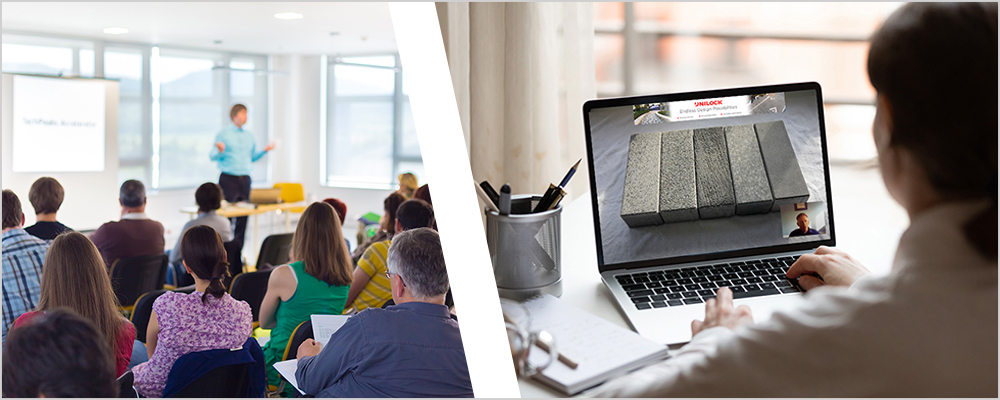Unlocking LEED Credit Opportunities with Unilock

Leadership in Energy & Environmental Design (LEED), is a green building certification program that recognizes best-in-class building strategies and practices that have a positive impact on the health of occupants, while promoting renewable, clean energy. To receive LEED certification, building projects satisfy prerequisites and earn points to achieve different levels of certification. Unilock products can contribute toward achieving your certification goals with sustainable components and characteristics, as well as Health Product Declarations (HPDs).
LEED Credit Opportunities with Unilock Pavers
LEED v4.1 Credit Category: Sustainable Sites
Rainwater Management (up to 3 points):
Implementing low-impact and green infrastructure design strategies that aid in reducing runoff and improving water quality present the opportunity to earn up to 3 points towards LEED certification. These points are achieved for retaining rainwater onsite based on the percentile kept. Permeable interlocking concrete paving (PICP) systems are one option that designers can employ to help meet the requirements for ‘Rainwater management’. They have the ability to both retain water onsite and mimic a site’s natural hydrology. See LEED v4.1 for more information on the allocation of points.
Heat Island Reduction – Non-Roof and Roof (up to 2 points)
Up to 2 points can also be awarded to projects that seek to reduce heat islands. Among a number of strategies outlined by the USGBC, the use of pavement that offers an initial solar reflectance of at least 0.33 can help meet the criterion for ‘Heat Island Reduction – Non-Roof and Roof’. The Solar Reflectance Index (SRI) is a criterion used by the U.S. Green Building Council (USGBC) that measures values of sunlight and radiation bouncing from built surfaces. It is used to measure urban heat island effects in city centers.
Dark pavement absorbs heat during the day and then releases it at night. This process creates a situation that causes urban centers to stay warmer all the time which contributes to air pollution and increased energy consumption. At Unilock, we have a selection of paver colors in both small format and large format shapes that have high SR values, helping to minimize urban heat island effects.
In addition to having areas on a site with high reflectance, the use of an open-grid pavement that is at least 50% pervious can also contribute to the reduction of heat islands. See LEED v4.1 for more details and information on the allocation of points.
LEED v4.1 Credit Category: Materials and Resources
Sourcing of Raw Materials (1 Point)
Choosing products from companies that demonstrate responsible sourcing of raw materials can offer points towards a LEED certification. Within the hardscaping industry, there is an opportunity to utilize recycled content in manufacturing of concrete pavers and walls.
Concrete typically contains a mixture of sand, coarse aggregate, water and the principal cementitious material, which is Portland cement.
Today, most concrete recipes also contain what’s known as supplementary cementitious material (SCM) admixtures. These can be by-products from other processes or natural materials that may or may not have been further processed for use in concrete. These materials may include Fly Ash (Class C or F), Ground Granulated Blast Furnace Slag (GGBFS), Silica Fume, Natural Pozzolans, recycled glass and more.
These admixtures can contribute toward achieving the cumulative minimum recycled content criteria for ‘Responsible Sourcing of Raw Materials’. If you wish to learn more about SCM’s available for custom orders, speak with your Unilock representative.
Within this credit category, materials that are extracted and products that are manufactured/purchased within 100 miles (160 km) of the project site are considered twice as valuable as their original contributing cost.
See LEED v4.1 for more details and information on the allocation of points.
Note: Unilock has several manufacturing plants in the U.S. and Canada. It is important to speak with a Unilock representative about material sourcing and product manufacturing for an accurate credit achievement calculation on your specific project/site. The values may range slightly by region ad by product, due to variations in local aggregate and granites.
Material Ingredients: Material Ingredient Reporting (1 point)
Within the requirements of this credit opportunity, USGBC outlines a number of programs that can be used to demonstrate the chemical inventory of a product. Health Product Declarations (HPD’s) are one of the accepted approaches. At Unilock, we offer material transparency through published HPD’s, providing a summary of product contents as well as the results from screening individual chemical substances against HPD Priority Hazard Lists and the GreenScreen for Safer Chemicals®. Therefore, Unilock products can help designers earn 1 point towards their LEED certification for ‘Material Ingredient Reporting’
See LEED v4.1 for more details and information on the allocation of points.
A LEED certified project shows a commitment to sustainability and dedication to environmental stewardship and responsible construction practices. Connect with a Unilock representative to learn more about how our products can help you achieve your LEED certification goals on your next project.



